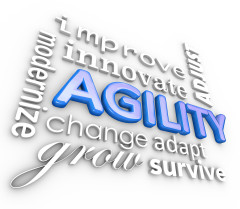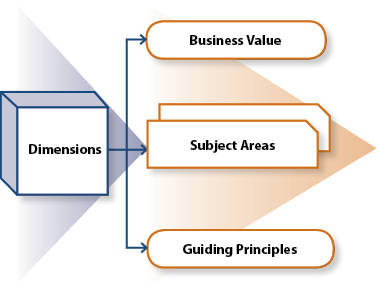… Embraces Agility

“When you’re finished changing, you’re finished.”
Benjamin Franklin
What is Agility?
Before getting into the Agility dimension, the next building block of A Better Workplace, we should spend a little time to cover what I mean by agility, and why it matters in today’s business world.
Depending on one’s perspective, the term agility can mean different things. To an application developer, agility implies those principles that relate to The Agile Manifesto. They are implemented in many ways, the most common being combinations of SCRUM, Lean/Kanban, and Extreme Programming.
To someone on the business side, the term could imply agile enterprises, agile marketing, agile decision-making, and so on. All uses should share some common capabilities:
- An agile enterprise is change-proficient, whether that change is driven by market trends or is internal and operational. It responds quickly to both threats and opportunities, and executes change in a sustainable way (CIO.com).
- Business agility refers to distinct qualities that allow organisations to respond rapidly to changes in the internal and external environment without losing momentum or vision. Adaptability, flexibility and balance are three qualities essential to long-term business agility (HRZone).
Agile organizations generally share the following characteristics:
- Effective communication, from executives to workers, workers to executives, and across organizational boundaries;
- Managers and workers in contact with customers (internal and external);
- High tolerance for failure, using experiments to test ideas and failure as a shared learning experience; and
- Decentralized decision-making, delegating authority as much as possible.
Why Does It Matter?
In our rapidly changing world, organizations needs to be much more responsive to both external threats and internal opportunities. Some data on the benefits of agile and the consequences of non-agility:
- Overall, the findings show that companies with highly mature business agility characteristics – the Business Agility Leaders – exhibited superior financial performance (IBM):
- 13% to 38% performance advantage in capital efficiency and value
- 10% to 15% performance advantage in margins
- Up to 5% performance advantage in revenue and earnings growth
- According to Craig Le Clair, Vice President and Principle Analyst at Forrester Research, 70% of the companies that were on the Fortune 1000 list ten years ago have now vanished – unable to adapt to change (Forbes.com).
From the perspective of A Better Workplace, beyond the fact that the organization for which someone works is more likely to survive if they’re agile, there are other benefits that impact the individual work experience:
- People like working for successful organizations;
- Greater delegation of authority gives workers more sense of control; and
- Empowered teams can quickly eliminates performance inhibitors.
Agility Dimension

With that background, let’s look at the Guiding Principles for the Agility dimension:
- Communication is key – up, down, sideways – Agile organizations rely on information and informed decision-making, and that only happens when people communicate broadly.
- Managers & workers in touch with stakeholders – To make informed decisions, we need input from all stakeholders, most importantly our customers (internal and external).
- Failure tolerance – Agile organizations frequently experiment and test new ideas. When they don’t work as desired, that “failure” is treated as a learning opportunity.
- Sharing of lessons – When one team’s experiment fails, those lessons are shared broadly in the organization.
- Decentralized decision-making – This is another foundation element of agile organizations. In order to respond quickly, decisions need to be made as close to the actual work as possible. This also means that organizations will need decision-making frameworks that guide these decisions.
Given those Guiding Principles, let’s look at the Subject Areas:
- Communication – How effectively does “real” information (not gossip) flow throughout the organization, and how successfully is the information used?
- Stakeholder involvement – We try to understand how inclusively stakeholders, both internal and external, are involved in shaping decisions, and their roles in product / service delivery.
- Failure tolerance – One catch-phrase in agile is, “Fail early, fail often,” knowing that failures lead to better understanding and more appropriate solutions. We discuss how those failures are viewed across the teams, and how the organization responds to the failures.
- Organizational learning – It’s important for the broader organization to learn from team’s failures, so we discuss how the lessons learned are truly that – lessons learned – rather than lessons documented and forgotten. Organizational learning also includes the needs of customers, changes in the business environment, and other competitive forces and opportunities.
- Decision-making – Where are decisions really made? How much is actually delegated, and how empowered are the individual teams?
- Process oversight – One of the challenges of agile is establishing the proper balance between chaos on one hand and too much process on the other. We try to understand how the organization manages this balance.
- Adoption support – As new teams move from traditional process models to agile, they typically need some support from experts who have “been there, done that.” Here, we try to understand how this challenge is met across the organization.
- Technical agility support – For the technologists deploying agile development methods, the transitional support needs can extend internally, to facilities, infrastructure and staffing issues.
What’s Next
Next week, will address the sixth (and last) building block – Management Style.
Until Then …
“It is not necessary to change. Survival is not mandatory.”
W. Edwards Deming

What are your thoughts? Please share your comments in the block below.